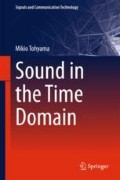Abstract
The probability distribution associated with a random variable is a basic notion on which signal analysis of sounds is based. The probability distribution for a sum of a pair of independent random variables underlies the notion of convolution that is basic to signal analysis from the point of view of the linear system theory. The correlation between a pair of random variables is a standard metric to characterize pairs of random variables as well as the independence of random variables. The difference between the uncorrelated (or orthogonality) and statistically independent pairs of random variables renders typical auditory effects on sound image sensations. The perception of sound image experienced during binaural listening to an independent pair of random noise is called subjective diffuseness. An example of the probability density function for a sinusoidal wave is given to help understand orthogonality as being different from the statistical independence. The square correlation is a measure that represents the energy ratio of the uncorrelated pair of variables. Direct sound and its reverberation is a typical example of an uncorrelated pair in reverberant sound fields.
Access this chapter
Tax calculation will be finalised at checkout
Purchases are for personal use only
References
R. Nelson, Probability, Stochastic Processes, and Queueing Theory (Springer, Berlin, 1995)
Y. Ando, Auditory and Visual Sensation (Springer, Berlin, 2009)
P. Damaske, Subjective Untersuchung von Schallfeldern, Acustica 19 199–213 (1967/68)
M. Tohyama, A. Suzuki, Interaural cross-correlation coefficients in stereo-reproduced sound fields. J. Acoust. Soc. Am. 85(2), 780–786 (1989)
D.H. Cooper, Notions of conventional stereo interaural cross-correlation coefficients in stereo-reproduced sound fields; Interaural cross-correlation coefficients in stereo-reproduced sound fields J. Acoust. Soc. Am. 85 780–786 (1989). J. Acoust. Soc. Am. 86(6), 2452–2454 (1989)
K.J. Gabriel, H.S. Colburn, Interaural correlation discrimination I. Bandwidth and level dependence. J. Acoust. Soc. Am. 69(5), 1394–1401 (1981)
S. Hirobayashi, Private communication (2003)
Author information
Authors and Affiliations
Corresponding author
Rights and permissions
Copyright information
© 2018 Springer Nature Singapore Pte Ltd.
About this chapter
Cite this chapter
Tohyama, M. (2018). Sinusoidal Waves as Random Variables. In: Sound in the Time Domain. Signals and Communication Technology. Springer, Singapore. https://doi.org/10.1007/978-981-10-5889-9_2
Download citation
DOI: https://doi.org/10.1007/978-981-10-5889-9_2
Published:
Publisher Name: Springer, Singapore
Print ISBN: 978-981-10-5887-5
Online ISBN: 978-981-10-5889-9
eBook Packages: EngineeringEngineering (R0)

